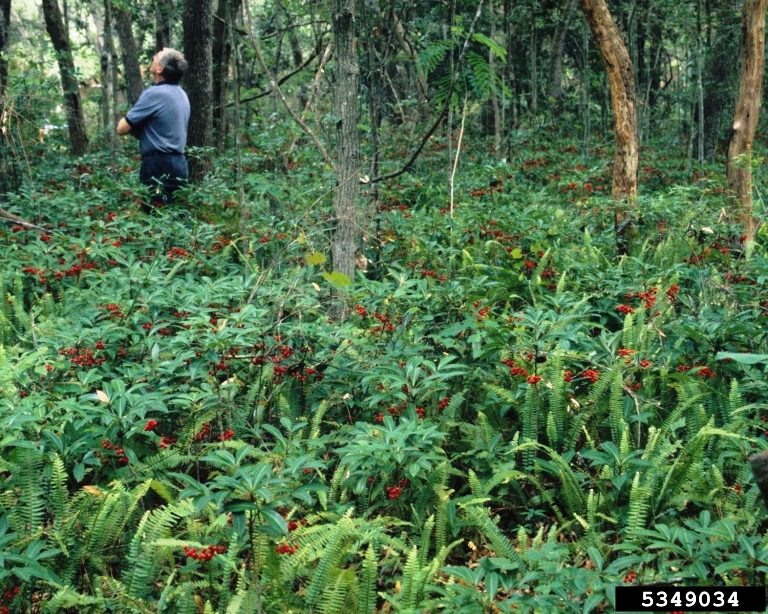Coral ardisia (Ardisia crenata) is an invasive non-native plant, introduced into Florida in the early 1900’s for ornamental purposes. It is now found growing in hardwood hammocks and other moist woodlands of both wild and grazing lands. In addition to overtaking native vegetation, this plant is suspected of being poisonous to livestock, pets, and humans. In the Florida panhandle, coral ardisia has been documented in the counties of Calhoun, Franklin, Gadsden, Gulf, Jackson, Leon, and Wakulla, and is likely spreading further. Because of its invasiveness and potential toxicity, it is important to recognize this plant as you scout your pastures and woods for weeds.
Coral ardisia is a small evergreen shrub which grows in clumps up to 6 feet tall. Leaves are alternate, 8 inches long, dark green, shiny and waxy, with scalloped edges. Flowers are pink to white growing in clusters, usually drooping below the leaves. The fruit is a bright red (rarely white), spherical berry, about 0.25 inch in diameter. It grows best in shade to part-shade, in moist well drained soils, and is spread by animal-dispersed seed. Because coral ardisia is an evergreen plant, it is more readily noticeable in the late fall, winter, and early spring. Be sure to scout the woodlands and woodland edges of your pastures for this plant.

Shiny, dark green Coral ardisia leaves, showing scalloped edges.
James H. Miller, USDA Forest Service, Bugwood.org
There is no published literature supporting that coral ardisia is toxic. However, there are two cases in Florida where this plant was suspected to be the cause of death of livestock in 2001 and 2007. Berries tend to persist on the plant nearly year-round. It is suspected that the berries and/or foliage are poisonous to livestock, pets, and humans.
Coral ardisia can be managed by using low-volume foliar applications of a 5% solution of the herbicides Garlon-4 or Remedy, or basal bark applications with an 18% solution of Garlon-4 or Remedy in an oil carrier. Do not apply more than 8 quarts of Remedy or Garlon-4 per acre and treat no more than 10% of the total grazed area if applying greater than 2 quarts per acre. Use care when applying high rates of these herbicides when temperatures exceed 90oF as these formulations can volatilize and drift under such conditions. Regardless of application method, re-treatment will be necessary for satisfactory control.
Please feel free to call your local UF/IFAS County Extension Agent for help in identifying and managing this plant. For more information click on the following links to view the resources used for this article: Identification and Control of Coral Ardisia (Ardisia crenata) – A Potentially Poisonous Plant, Center for Invasive and Aquatic Plants, Toxic plants, Florida Invasive Species Partnership.
- Maintaining Dissolved Oxygen Levels in Your Pond to Reduce Fish Kills - September 21, 2018
- The Bumble Bee – One of Florida’s Vital Pollinators - September 14, 2018
- 2017-2018 Bee Informed Partnership’s National Bee Colony Loss Report - July 13, 2018


